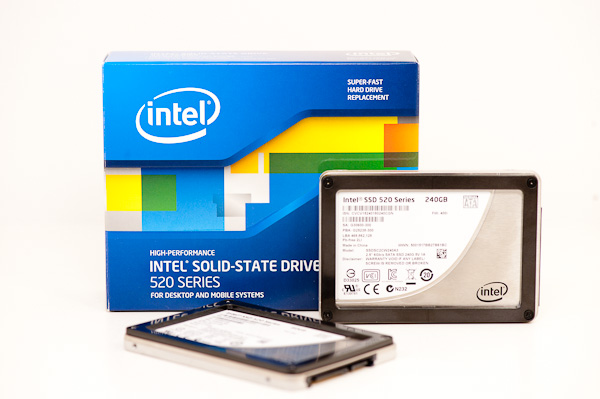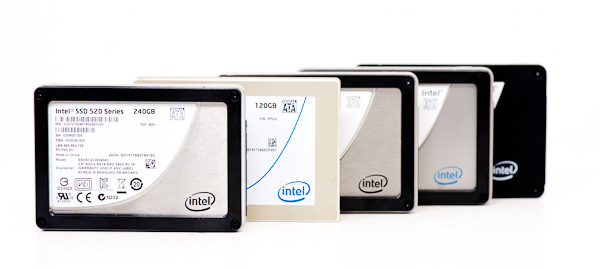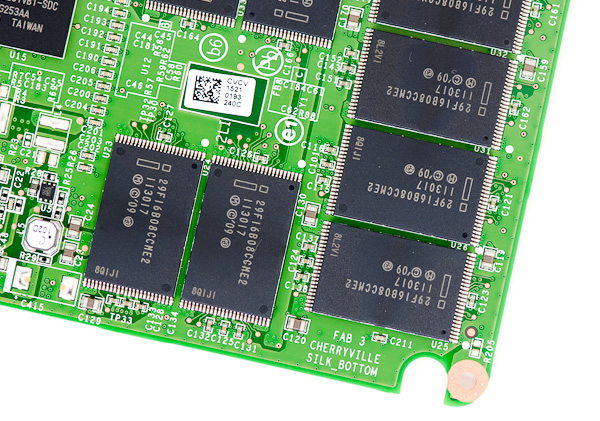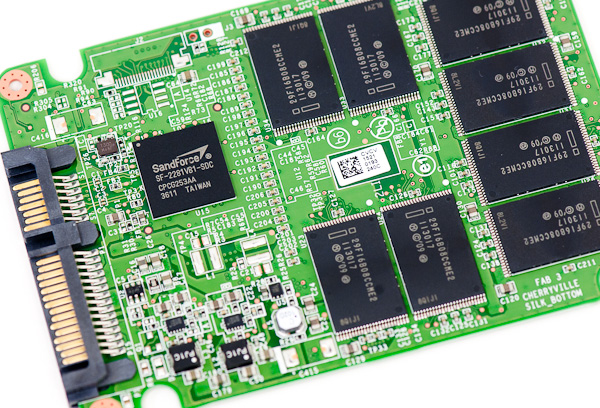Intel SSD 520 Review: Cherryville Brings Reliability to SandForce
by Anand Lal Shimpi on February 6, 2012 11:00 AM ESTIntel was rumored to be working on a SandForce based drive for several months now, but even the rumors couldn't encapsulate just how long Intel and SF has worked on this drive. According to Intel, the relationship began 1.5 years ago. Still lacking a 6Gbps controller of their own and wanting to remain competitive with the rest of the market, Intel approached SandForce about building a drive based on the (at the time) unreleased SF-2281 controller. Roughly six months later, initial testing and validation began on the drive. That's right, around the time that OCZ was previewing the first Vertex 3 Pro, Intel was just beginning its extensive validation process.
Codenamed Cherryville, Intel's SSD 520 would go through a full year of validation before Intel would sign off on the drive for release. In fact, it was some unresolved issues that cropped up during Intel's validation that pushed Cherryville back from the late 2011 release to today.
Intel's strenuous validation will eventually make SandForce's drives better for everyone, but for now the Cherryville firmware remains exclusive. Intel wouldn't go on record with details of its arrangement with SandForce, but from what I've managed to piece together the Intel Cherryville firmware is exclusive for a limited period of time. That exclusivity agreement likely expires sometime after the SF-2281 is replaced by a 3rd generation controller. There are some loopholes that allow SandForce to port bug fixes to general partner firmware but the specific terms aren't public information. The important takeaway is anything fixed in Intel's firmware isn't necessarily going to be fixed in other SF-2281 based drives in the near term. This is an important distinction because although Cherryville performs very similarly to other SF-2281 drives, it should be more reliable.
As Intel has been working on this firmware for quite a while, it's likely that the 520 uses an older branch of the SF-2281 firmware that has been updated over the past twelve months.
The BSOD is Back, but Not on Intel
Back in October SandForce announced that it had discovered a firmware issue that resulted in unexpected BSODs on SF-2281 drives on certain platforms. Why it took SandForce several months to discover the bug that its customers had been reporting for a while is a separate issue entirely. SandForce quickly pushed out the firmware to OCZ and other partners. Our own internal testing revealed that the updated firmware seemed to have cured the infamous BSOD.
Just as background, our SSD testing is rarely over once the review goes live. Any drive we recommend gets tossed into a primary use machine somewhere within the company. We keep track of drive behavior, including any bugs or performance issues over time. This long term testing process takes place over months. The results of these long term tests are folded into future reviews and recommendations.
The BSOD is caused by a bug in SandForce's power state logic that ultimately results in the drive disconnecting from the system while it's running. It turns out that Windows isn't a fan of you hot un-plugging the drive it's running on, which results in the BSOD. We had two systems that exhibited the BSOD, both of which were fixed by the update last October.

As luck would have it, our own Brian Klug happened to come across an unexpected crash with his 240GB non-Intel SF-2281 based SSD two weeks ago when he migrated it to another machine. The crash was an F4 BSOD, similar in nature to the infamous BSOD issue from last year. While two of the systems we reproduced the BSOD bug on were cured by last year's firmware update, Brian's system (an X58/Core i7 build) was BSODing regularly playing Battlefield 3. Games end up being a great way to trigger the SF-2281 BSOD issue as they frequently switch between periods of idle and load, which does a good job of stressing the power state logic in SandForce's firmware. I immediately sent Brian an Intel SSD 520 to see if the BSOD remained on Intel's drive. Switching to Cherryville caused Brian's BSODs to go away. Indeed most end user reports of SF-2281 BSODs went away with the fixed firmware, but we've still heard of isolated issues that remain unresolved. Whatever Intel has done with the 520's firmware seems to have fixed problems that still remain in the general SF-2281 firmware.
This is actually a dangerous precedent as it means one of two things. The first possibility is that SandForce has been made aware of flaws in its current firmware and chooses against (or is legally prevented from) disclosing it to its partners. The second possibility, and arguably even worse for SandForce, is that Intel was able to identify and fix a bug in the SF-2281 firmware without SandForce knowing it existed or was addressed. I suspect it's the former but as no one is willing to go on the record about the Intel/SandForce agreement I can't be certain.
Intel did go on record saying that the 520 is expected to have far fewer F4/F7 BSODs than any other SF-2281 drive. I asked Intel if I should read into the phrase "far fewer", but the answer was no - the 520 is expected to have similar reliability to the Intel SSD 510 and 320.
At the end of the day that's what Intel really brings to the table with the 520. As you'll soon see, performance isn't very different compared to other SF-2281 based drives. Intel's biggest advantage comes from the unique firmware that ships with the drive. Intel is also quick to point out that while other SF-2281 manufacturers can purchase the same Intel 25nm MLC NAND used on the 520, only Intel's drives get the absolute highest quality bins and only Intel knows how best to manage/interact with the NAND on a firmware level. While it's nearly impossible to prove most of this, the fact that we're still able to reproduce a BSOD on the latest publicly available SF-2281 firmware but not on the SF-2281 based Intel SSD 520 does say a lot about what you're paying for with this drive.
And you are paying a premium for the 520 compared to other SF-2281 based SSDs on the market today:
| Intel SSD 520 Price Comparison | |||||||
| 60GB | 120GB | 180GB | 240GB | 480GB | |||
| Intel SSD 520 (SF-2281) | $149 | $229 | $369 | $509 | $999 | ||
| Kingston HyperX (SF-2281) | N/A | $205 | N/A | $420 | N/A | ||
| OCZ Vertex 3 (SF-2281) | $95 | $190 | $240 | $375 | $850 | ||
| Samsung SSD 830 | $110 | $220 | N/A | $360 | $800 | ||
Last year Intel hinted at a move from the consumer market to enterprise server and client markets. The 520's higher price likely won't matter there, but for consumers the higher price is noticeable - particularly with good options from companies like Samsung now available on the market.














138 Comments
View All Comments
ckryan - Tuesday, February 7, 2012 - link
True, but the 520 series isn't the 320 series. Intel has the 510 and 520 series to satisfy the user that desires speed, but the fact is Intel will sell more SATA II than SATA III drives for the next few years.lyeoh - Tuesday, February 7, 2012 - link
Maybe making fast expensive drives and selling them for profit isn't Intel's main goal. Perhaps Intel is trying to push the SSD market to the next step.Nowadays drives are often the biggest performance bottleneck, and so it stops making a big difference whether you buy a top of the line Intel CPU or not, or even buy AMD instead.
But once fast SSDs start becoming more reliable and sell at closer to _commodity_ prices, then Intel can get back to selling powerful CPUs to more people.
A marketplace full of fast expensive SSDs that BSOD and lose data and slow cheap hard drives doesn't help for such a goal.
But helping Sandforce _eventually_ get their act together (Intel aren't doing this for free of course) might do so. They might also be concerned about Samsung.
NitroWare - Wednesday, February 8, 2012 - link
"Perhaps Intel is trying to push the SSD market to the next step."Intel has frequently done this with different technologies.So it is logical.
In the article, Intel claimed they had 100% of staff on Intel SSD. Vendors usually do not make claims about internal employee hardware.
Ethernet, Wifi, PCI, Legacy free, non x86 ISA (Xscale, Itanic), Fibre, PC I/O and RAM Technologies.
They even dabbled with video conferencing years ago
gramboh - Monday, February 6, 2012 - link
I'm in the market for a 240gb SSD in the next few months, and would love to buy a 520 series over other SF-2281/Marvell options, but right now it's a 42% price premium which is way too much.The 120gb has a more realistic price premium of about 25% (taking into account rebates on the 2281/Marvell drives) which I would consider, would have been nice for Intel to price the 240gb at $400-430.
mckirkus - Wednesday, February 29, 2012 - link
"Would have been nice for Intel to price the 240gb at $400-430"The 240gb version is $357 on Amazon right now (2/29).
LeftSide - Monday, February 6, 2012 - link
I bought the Kingston version on Black Friday for $120 after MIR. It was a great deal. Although I did worry about the BSOD (especially right after sending in the MIR). Thankfully, I haven't had any problems and it has been an excellent drive. It's unbelievably fast.NitroWare - Wednesday, February 8, 2012 - link
They have the 332 firmware available for download from their website. There is even a toolbox utility now but this only has SMART features and no wipe tool.jaydee - Monday, February 6, 2012 - link
Would you expect the 120GB version to perform similar to the 60GB or the 240GB version? Or right down the middle?extide - Monday, February 6, 2012 - link
Historically, 128GB drives have seemed to perform closer to the 240/256GB counterparts than the 60/64GB ones. That's just my observation, though.ckryan - Monday, February 6, 2012 - link
It's closer to the 240GB in performance. The 60GB SF drives are really at a disadvantage, especially in sequential writes. There have been benches of the 120GB 520 for some time, but the 240GB is unquestionable faster. You might not notice the difference in real usage. You can look at Anand's 120GB roundup from last year, and the 120GB version should come out slightly ahead of the Vertex 3.